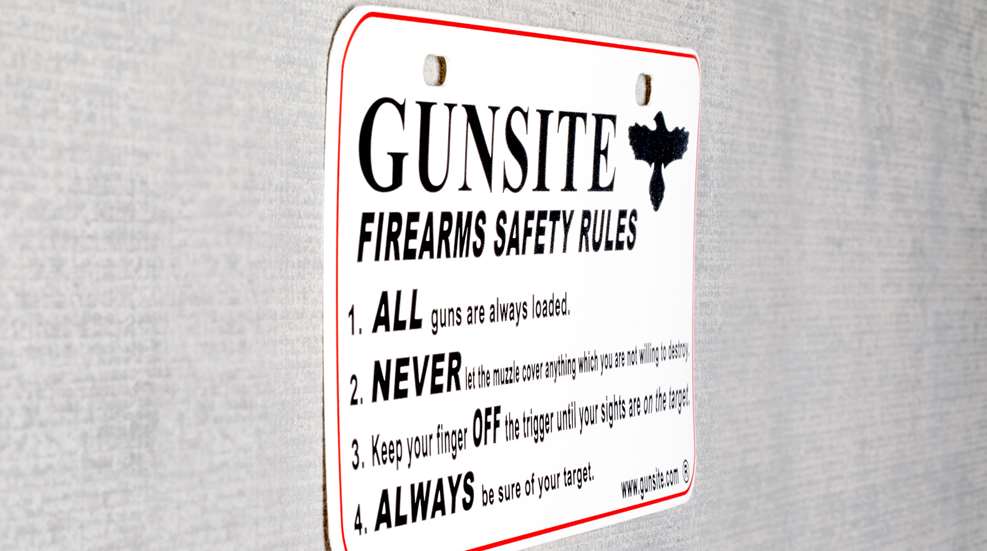
The fundamental firearm safety rules we all rely upon when on the range or in training can also help keep you safe when defending yourself from a criminal attack.
My favorite firearms safety rules were the four that Col. Jeff Cooper gave us. To review, they are:
#1. All guns are always loaded.
#2. Never let the muzzle cover anything which you are not willing to destroy.
#3. Keep your finger off the trigger until your sights are on the target.
#4. Always be sure of your target.
We are reminded of these rules on the range and in every practice and training session. They obviously apply to every time and every reason that we might handle a firearm. But, I think we also need to be reminded that they apply to the use of the firearm in actual defensive situations. While this should be obvious, giving thought to these simple safety rules expands to our general use of firearms in a deadly situation.
For example: “All guns are always loaded.” This reminds me of the time, years ago, that I set out to confront a burglar with an unloaded gun. Unknown to me, a family member had taken it upon herself to unload my .38 Spl. Colt revolver. The thinking was along the lines of ”Loaded guns are dangerous, you know.”
To this day, that incident has caused me to add to Rule 1 to the extent that whenever a gun is out of my care, custody and control, I check it to make sure it is still loaded. When it has been out of my sight, I check it. When I dress in the morning, I check it before I put it on. It has become a habit, and good habits can be important.
“Old Tried and True” may not be the latest thing in defensive firearms, but if you can run it without consciously thinking about its operation, you may well be ahead of the problem.
Some of us have come to call Rule 3 the Golden Rule. In an actual gunfight, all sorts of things can be going on. There can be pushing, shoving, running and falling down. In addition, there is something called “sympathetic reflex.” That is, when the support hand does something—sudden gripping, for instance—the gun hand may do the same. All of this aggressive activity, plus the stress involved, can cause a negligent discharge if the trigger finger is anywhere near the trigger, possibly resulting in the bullet finding an unintended target. We continue to see this sort of occurrence referred to as an accident when, in fact, it is a failure to manage the firearm safely during the stressful situation.
We can extend this rule to cover the fact that the actual management of the firearm during a criminal attack must almost become second nature. During a violent incident, we are most concerned with identifying the threat. How many are attacking? How are they armed? Where is the closest cover? How can I move to improve my situation? Clearly, the most important considerations involve the attackers and what I am going to be able to do about it.
Any time spent consciously managing the gun may well be valuable time that is wasted. Checking to see if the gun is loaded, checking to see if the safety is on or checking to see if the electronic sight is on or off are all tasks that take you away from what should be your primary focus, which should be defeating bad guys in the most efficient manner.
This is the main reason that we discourage armed citizens from continually switching to different kinds of carry guns. “Old Tried and True” may not be the latest thing in defensive firearms, but if you can run it without consciously thinking about its operation, you may well be ahead of the problem. While the decision to fire a shot should always be a conscious decision, the management of the gun itself should be second nature.
And when I think of Rule 4, I immediately think of violent encounters in public. The problem is not just the criminal; it is also all of the people running every which way trying to get out of the way. I may have a clear shot at the shooter, but I have to always consider the people who may suddenly appear behind him, or run between us in their attempt to escape or bump into me when I am about to break the shot. And, I have to remember that I own every bullet I fire. It simply means I have to be careful—almighty careful—and may mean that I can’t fire at all.
So, I suggest that armed citizens should take their chosen safety rules, whatever those might be, and give thought to how they will apply in an actual gunfight. One can examine videos of actual gunfights and shootings online to get an idea of what can occur and how to deal with them in the safest manner. What were the obvious mistakes? What were the choices that the armed citizen or police officer had? What might have been done better for the safety of all concerned?
We study, we practice, we learn and we become harder targets.


































